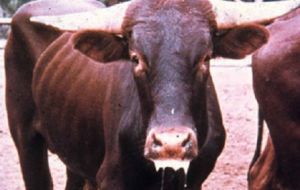MercoPress. South Atlantic News Agency
FMD emergency in Korea: 26.000 animals at 211 farms culled
 The FMD outbreak has spread rapidly
The FMD outbreak has spread rapidly Shortly after declaring itself “clear” of the foot-and-mouth disease (FMD) on March 23, South Korea is yet again battling the animal disease that was found to have contaminated a local cattle farm last Friday.
It took less than three weeks for the FMD to resurface in South Korea, which in January had affected the country for the first time in eight years, and the country is scrambling again to contain further spread of the highly-contagious disease that mainly affect cloven-hoofed animals including pigs, cattle, and goats.
A new outbreak of the foot-and-mouth disease (FMD) was confirmed in a cattle farm west of Seoul last Friday, where 10 out of the 180 “hanwoo” or Korean beef cattle had shown blisters on the mouth and teats, causing quarantine officials to cull livestock within a 500 meter radius of the cattle farm in order to prevent further spread of the disease, the Ministry for Food, Agriculture, Forestry and Fisheries said.
According to the ministry, animals on the farm on Ganghwa Island, 58 km west of Seoul, started showing signs of the FMD symptoms on Thursday. Quarantine officials immediately took precautionary measures by closing off the farm and limiting movement of people and vehicles in the area.
The ministry said that they are still investigating the exact cause of the outbreak. The owner of the farm had recently made a visit to a region in [a] neighbouring country that reported a FMD outbreak last week.
Quarantine officials also started culling cloven-hoofed animals near the contaminated cattle farm on Friday, where some 2,500 heads of cloven-hoofed livestock, including 2,200 pigs within a 500-meter radius of the cattle farm, were culled to prevent further outbreaks of the disease.
However, by Saturday the ministry expanded the culling area to a 3 km radius of the affected farm as preventive measures, and raised its four-level animal disease alert status from the “blue” level to the second-highest “orange” level.
So far, five cases of the FMD have been confirmed since Friday, according to the farm ministry, as it said more than 26,000 animals at 211 farms around the affected area will be culled to contain the disease from spreading to other regions.
Meantime in Melbourne an international FMD symposium said that the disease remains the greatest single threat to Australian livestock industries. The meeting also coincides with the launch of a five-year 5 million USD research program, funded by Australia's livestock industries and the Federal Government, to address weaknesses in Australia's readiness to control the disease.
Cattle Council of Australia board member Peter Milne said FMD was an issue for government and susceptible livestock industries, not only because of production losses and the cost of eradication but because an outbreak anywhere in Australia would close export markets overnight.
According to the Australian Productivity Commission, national economic losses would be in the order of 4 million USD a day should an outbreak occur.
“The impact of the FMD outbreak of 2001 on United Kingdom farmers is an enduring memory for all of us,” Mr Milne said.
He said the 2001 UK outbreak had been a catalyst for action in Australia and the development of a national plan - the Emergency Animal Disease Response Agreement, signed by the federal and state governments as well as industry groups - but that subsequent progress had been more modest.




Top Comments
Disclaimer & comment rulesCommenting for this story is now closed.
If you have a Facebook account, become a fan and comment on our Facebook Page!